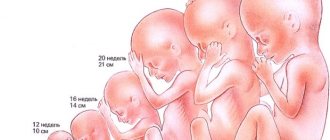A child turns over on his stomach in a dream: reasons, development standards, advice from doctors and parents
Isn't it interesting to watch a small child grow, develop and acquire new skills? For most parents, one of the first exciting developmental milestones is watching their babies learn to roll over. The first time you see your baby arch his back, lift his head, lean to the side, and then suddenly - flip! So cute and exciting, but! Unless it happens that the child is sleeping and rolls over on his stomach. Then it becomes frustrating and tiring. Why? Because a baby who is just starting to roll over is a baby who is not sleeping.
A child turns over on his stomach in his sleep: safety comes first!
Can a baby sleep on his stomach? Short answer: no. A baby sleeping on his stomach inhales less air. This increases the likelihood of sudden infant death syndrome (SIDS). In 2015, about 1,600 children died from this cause!
Now, as for how to help your baby through this stage and maximize everyone's sleep: First of all, remember that there is no “cure” for this. Baby rolling is a completely natural part of his growth and development, so there is nothing you can do to correct or stop this process.
However, some parents find that turning the baby over every time the baby rolls onto his or her stomach in sleep is a great way to help your baby get through this stage. This is especially true for children who can only roll in one direction, but cannot yet learn to roll in the other, and who do not really like to “freeze” in a certain position. Since this stage is usually short-lived (usually 2-3 weeks), this is a simple, short-term solution.
First of all, it is important to make sure that the baby's newfound mobility does not create a dangerous situation when the baby rolls onto his stomach in his sleep.
It is known that babies should always be put to sleep on their back, but if they lie on their tummy, then depending on their age and capabilities, you can either return it back face up or leave it in this position.
The safest place for a baby to sleep is in his crib in the same room as his parents or adults. But what if the baby rolls over on his stomach in his sleep? Does it still need to be returned?
Why does a baby roll over on his stomach in his sleep and wake up, reasons and what to do
Starting from the second or third month of life, the baby tries to roll over onto his tummy. The baby practices a new skill throughout the day and even at night.
The newly acquired skill indicates the baby’s proper development and coordination of movements. But many mothers are concerned about the fact that the baby turns over on his stomach in his sleep, begins to whine, gets up and wakes up.
Should you worry about this and how to keep your baby as safe as possible while sleeping is discussed below.
Can a baby sleep on his stomach?
If the baby does not wake up after turning on his tummy and sleeps until the next feeding, then there should be no reason for parents to worry about the sleeping position.
After all, the body position that seems uncomfortable to parents, namely: the child sleeps with his back up, standing up on his knees and pressing his legs to his tummy, is a natural process for the baby, inherent in nature.
This body position imitates the position of an embryo in the mother's womb.
But if, when turning onto the tummy, the baby begins to cry and wake up, then it’s worth thinking about the reasons for the baby’s discomfort.
Benefits of falling asleep on your tummy
The main benefits of sleeping on your tummy are:
- The baby’s skeletal system has not yet strengthened, so sleeping on his stomach will relieve the spine from unnecessary stress;
- the position of the body in the fetal position helps to normalize the functioning of the digestive system, because from the first days the child is placed on his tummy;
- improving blood supply to the brain;
- prevention of developmental pathology – hip dysplasia;
- when regurgitating, the baby will not choke on vomit;
- The neck muscles are strengthened by turning the head, and the child begins to hold his head up earlier.
When the baby’s belly button has not yet healed, and the baby is always trying to fall asleep on his stomach, then this body position also contributes to the speedy healing of the umbilical wound and the elimination of colic.
https://www.youtube.com/watch?v=CRj3bAFWtPs
You just need to make sure that the baby is comfortable and periodically turn the baby on its side.
Possible causes of coups
If a child turns on his stomach and begins to cry, the root cause of this should be identified.
First you need to check if the child is comfortable:
- no folds appeared on the bed or in things that cause discomfort to the baby’s delicate skin;
- whether the baby’s breathing is difficult due to non-compliance with temperature, humidity, cleanliness and lack of dust in the room;
- the baby is hot or cold;
- is the diaper dry, comfortable clothes, a cap without ties;
- whether the child is twisted in diapers or a blanket;
- whether the child is exposed to air from the air conditioner or heat from heating devices;
- Is there any loud noise or light in the room?
If the above reasons have been eliminated, but the child begins to cry as soon as he turns over on his stomach, the physical causes of the baby’s anxiety should be eliminated:
- Colic, bloating, discomfort and pain in the tummy. In this case, the baby cries for a long time without calming down, pulls up his legs, is capricious, and asks to be held in his mother’s arms.
- Congestion of the digestive system and intestines. Children who are introduced to complementary foods at 4 months may not yet be ready for such foods. Even if complementary foods are introduced after 6 months, the baby’s body may not yet be ready to accept “adult” food - it has not produced the required amount of enzymes for processing.
- Increased muscle tone. A characteristic sign is the head tilted back upward during sleep, the arms pressed tightly to the body.
- Poor development of the nervous system. In this case, the baby jerks his limbs sharply and scares himself.
- Teeth are coming through.
- Nasal congestion, runny nose, breathing problems.
- Increased body temperature caused by infections, viruses or after vaccination.
- An allergic reaction, which may be accompanied by other symptoms: itching, redness of areas of the body, rash, rapid heartbeat, difficulty breathing.
These reasons are a reason to contact a pediatrician, neurologist or gastroenterologist to determine treatment options.
Sleeping on your stomach and safety
Despite all the fears and concerns of mothers and fathers, sleeping on the tummy is necessary for a child, in the absence of contraindications. It is only important to ensure the safety of the baby:
- Carry out a set of gymnastic exercises with your child that strengthen the baby’s body;
- iron the baby’s things and bed;
- buy a hard mattress, remove the pillow;
For children under one year old, the pillow is contraindicated; a diaper folded in four is sufficient.
- Do not put soft toys or rattles in the playpen. The former can cause allergies, the latter can wake up the baby;
- hang bumpers on the playpen to prevent the child from bumping;
- when bathing, add chamomile decoction to the bath, which calms the nervous system;
- an hour and a half before bedtime, exclude active games and cartoons;
- ventilate and moisten the room, iron things and beds;
- after feeding, carry the baby vertically in your arms, and only then transfer him to the playpen;
- Avoid using detergents with fragrances.
Some people associate sudden infant death syndrome with falling asleep on the stomach, but the assumptions have no scientific basis.
How to prevent your baby from rolling over?
If turning your baby onto his tummy during sleep causes excessive anxiety, you can try to prevent the process:
- Swaddle your newborn before bedtime.
- Place your baby on his side in the playpen before going to bed. And place soft cushions under the tummy and back.
- Change the crib to a stroller cradle or a “cocoon nest” that limits the baby’s activities.
- Sleep together with the baby, controlling the baby's sleep positions.
- Place the baby to sleep immediately on his tummy with his head turned to the side.
Why is sleeping on your back so important?
Infant deaths associated with sudden unexpected death (SIDS) have fallen by 80% since safe sleep campaigns were introduced in the 1990s. Experts estimate that 9,500 babies' lives were saved in Australia alone.
There is now strong evidence in many countries that the position of a newborn turning over on his or her stomach during sleep significantly increases the risk of sudden death. Research has also found side sleep position instability, with many babies found on their tummy after being placed to sleep on their side. Babies born prematurely are at increased risk of sudden death more often.
The good news is that the risk of SIDS decreases significantly before your baby's first birthday. It peaks between 1 and 4 months of age and then begins to decline. In fact, 90 percent of SIDS cases involve babies under 6 months of age.
Why does a child roll over on his stomach in his sleep? The position in which we sleep determines how easily and how often we wake up during sleep. Arousal is a physiological defense mechanism that is thought to be deficient in children who succumb to sudden and unexpected death.
What causes SIDS? What we know, don't know and suspect
When we fall asleep, our blood pressure, heart rate and breathing slow down, and there may be pauses in breathing (apnea). Brief awakenings from sleep increase all these indicators.
Studies done on babies have shown that placing a baby on their stomach not only makes it more difficult for them to wake up, but also reduces blood pressure and the amount of oxygen available to the brain. Parents sometimes place their baby on their stomach because they “sleep better that way.” This is because babies don't wake up in this position very often.
However, keep in mind that sleeping on your back improves airflow.
Does sleeping on your back interfere with burping?
Some parents are concerned that when a baby rolls over on his stomach in sleep, he is at risk of choking on vomit (baby burping is inevitable at this age). But a careful study of the child's respiratory tract showed that children who fall asleep on their backs are less likely to choke on vomit than those sleeping on their stomachs, no matter how paradoxical this may sound.
In the supine position, the upper respiratory tract lies above the digestive tract. Thus, the milk regurgitated by the baby, rising up the esophagus, is again easily swallowed and does not enter the respiratory tract. When a baby is placed on his stomach, the esophagus is positioned over his upper airway. If a baby spits up or vomits milk, the milk or liquid can be inhaled relatively easily into the airways and lungs.
At what age can babies sleep on their stomach?
Babies begin to learn to roll over from their back to their stomach as early as four months. But it may take longer until the baby is about five or six months old because it requires stronger neck and arm muscles.
Therefore, pediatricians recommend that a baby sleep on his stomach no earlier than when he reaches one year of age. As a rule, at this stage children can already sit without support and roll over freely. During this period, the child is already strong enough to roll away to a safe place if he needs to.
How should parents react if the baby falls asleep on his stomach?
If mom or dad sees that their baby has rolled over on his tummy, do not immediately turn him on his side. However, it is worth considering that some nuances of this position exist and need to be taken into account.
- Special small pillow or lack thereof. Up to one year of age, an infant does not need a pillow to sleep. Most often it is replaced with a special thick diaper. If the baby sleeps on his stomach, there should not be a pillow nearby. Also, there should be no toys or other objects that could in any way harm the child. After a year, the baby should buy a special small pillow for children.
- How to properly arrange a baby's crib. When a baby sleeps on his stomach, he can crawl and take the most incredible positions in his sleep. To prevent this from happening, you can cover the baby with pillows, this will make it difficult for him to turn over in his sleep. Also in this sense, the cradle is a great help. Swaddling to prevent turning over during sleep is not the best solution, as it hinders the baby's movements and also impairs blood circulation. Many parents, in order to control their child’s sleep, put him in their own bed, but this should not be done, since after sleeping together it is very difficult to teach the baby to sleep separately.
- Elimination of torticollis formation. As you know, if a baby is sleeping and his head is constantly tilted to one side, torticollis may develop. To prevent this, you need to ensure that the child’s neck is turned both to the left and to the right during sleep. This alternation serves as sleep prevention.
- Proper preparation of the baby for bed. In order for your baby to fall asleep soundly and peacefully, it is extremely important to provide him with a restful bedtime. To do this, it is important to exclude late TV watching and noisy outdoor games. You can give your baby a soothing massage, or give him a glass of warm milk at night. A bedtime story will also help your baby fall asleep. When bedtime is calm and parents are nearby, the baby quickly falls asleep and can even sleep all night without turning over once.
Of course, sleep in early childhood should be monitored to avoid problems. However, parents should treat this with less fanaticism. It should be remembered that kids are able to surprise with their funny actions and actions. The most important task of parents is to enjoy their child. Therefore, if in a dream the baby turns over from his back to his tummy, pulls his tiny legs under him and at the same time puts his fist in his mouth, snoring sweetly, you should not interfere with his sleep. When he gets older, you will tell him about this with emotion, indulging in reverent memories.
Source
Prevention measures
- Encourage tummy time play when your baby is awake, let him practice and lie on his back on his own as long as you can control him.
- Don't stop breastfeeding until at least 6 months.
- If you are still swaddling your baby, stop as soon as he starts to roll over. Plus, all that rolling will no doubt loosen the diaper, which can be a major suffocation risk. Instead of swaddling, try a sleep sack.
- Don't overheat the room, don't dress your child more warmly than necessary, and don't let anyone smoke near him.
How to prevent your baby from rolling over?
If turning your baby onto his tummy during sleep causes excessive anxiety, you can try to prevent the process:
- Swaddle your newborn before bedtime.
- Place your baby on his side in the playpen before going to bed. And place soft cushions under the tummy and back.
- Change the crib to a stroller cradle or a “cocoon nest” that limits the baby’s activities.
- Sleep together with the baby, controlling the baby's sleep positions.
- Place the baby to sleep immediately on his tummy with his head turned to the side.
Acceptability of sleeping on the stomach
At the end of the last century, American scientists described Sudden Infant Death Syndrome. Its main cause was said to be spontaneous cessation of breathing in a child, for example, if he sleeps with his face buried in a pillow. Due to poorly developed breathing skills and the inability to turn their head to the side, a baby in this position can easily suffocate. Despite the fact that there has not been 100% evidence of a direct relationship between sleeping on the stomach and sudden death syndrome, many pediatricians still recommend that parents refrain from putting the baby to sleep on the tummy to avoid undesirable consequences.
Important! All babies are different. If the mother sees that the baby is comfortable sleeping on his stomach, there is no need to be nervous and prevent this.
Sleeping on your stomach and safety
Despite all the fears and concerns of mothers and fathers, sleeping on the tummy is necessary for a child, in the absence of contraindications. It is only important to ensure the safety of the baby:
- Carry out a set of gymnastic exercises with your child that strengthen the baby’s body;
- iron the baby’s things and bed;
- buy a hard mattress, remove the pillow;
For children under one year old, the pillow is contraindicated; a diaper folded in four is sufficient.
- Do not put soft toys or rattles in the playpen. The former can cause allergies, the latter can wake up the baby;
- hang bumpers on the playpen to prevent the child from bumping;
- when bathing, add chamomile decoction to the bath, which calms the nervous system;
- an hour and a half before bedtime, exclude active games and cartoons;
- ventilate and moisten the room, iron things and beds;
- after feeding, carry the baby vertically in your arms, and only then transfer him to the playpen;
- Avoid using detergents with fragrances.
Some people associate sudden infant death syndrome with falling asleep on the stomach, but the assumptions have no scientific basis.
Contraindications
Whether or not to believe that sleeping on your stomach can cause sudden infant death syndrome is a personal choice for each parent. There are cases in which such a sleeping position is strongly recommended to be avoided. We are talking about the following points:
- If the baby has pathologies related to the functioning of the central nervous system.
- If the child sleeps without parental supervision.
- If the baby does not change position during the entire sleep period.
The famous doctor Komarovsky has his own opinion on what to do if a child turns over on his stomach at night. The specialist is convinced that under no circumstances should a baby sleep face down if the mattress in his crib is too soft and the air in the children’s room is dry and warm. If the baby is still very small, he should limit the space in such a way that it would be problematic for him to roll over, stand up or crawl.
There is no consensus on the acceptability of a child sleeping with his butt up
Advantages
If a child turns over on his stomach at night, you should not panic at all and rush to turn him back, especially if the baby is not one month old, but a little older (for example, six months).
Many parents note that a baby laid on its tummy can sleep longer and more peacefully than in other positions. This is due to the following reasons:
- the baby does not interfere with himself with his hands;
- in this position the throttles are released better;
- there is no risk that an infant will suffocate when regurgitating;
- accelerates the development of neck and abdominal muscles;
- intestinal function improves:
- hip joints form faster;
- The development of miliaria is excluded, since nothing is rotting.
Waking up when turning over on stomach
In some cases, the baby turns over on his stomach in his sleep and wakes up from this. Most often, these two processes are very indirectly related to each other. Therefore, if a child turns over on his stomach in his sleep, and also begins to cry when waking up, you should make sure that the baby could not have woken up because he was simply uncomfortable. First of all, you should make sure of the following:
- whether folds have formed on the bedding that are rubbing the baby’s delicate skin;
- whether the infant is tangled in the blanket;
- is the diaper wet?
- Are the clothes he sleeps in comfortable?
- Is the baby cold?
- Is the baby having difficulty breathing?
Possible causes of coups
If a child turns on his stomach and begins to cry, the root cause of this should be identified.
First you need to check if the child is comfortable:
- no folds appeared on the bed or in things that cause discomfort to the baby’s delicate skin;
- whether the baby’s breathing is difficult due to non-compliance with temperature, humidity, cleanliness and lack of dust in the room;
- the baby is hot or cold;
- is the diaper dry, comfortable clothes, a cap without ties;
- whether the child is twisted in diapers or a blanket;
- whether the child is exposed to air from the air conditioner or heat from heating devices;
- Is there any loud noise or light in the room?
If the above reasons have been eliminated, but the child begins to cry as soon as he turns over on his stomach, the physical causes of the baby’s anxiety should be eliminated:
- Colic, bloating, discomfort and pain in the tummy. In this case, the baby cries for a long time without calming down, pulls up his legs, is capricious, and asks to be held in his mother’s arms.
- Congestion of the digestive system and intestines. Children who are introduced to complementary foods at 4 months may not yet be ready for such foods. Even if complementary foods are introduced after 6 months, the baby’s body may not yet be ready to accept “adult” food - it has not produced the required amount of enzymes for processing.
- Increased muscle tone. A characteristic sign is the head tilted back upward during sleep, the arms pressed tightly to the body.
- Poor development of the nervous system. In this case, the baby jerks his limbs sharply and scares himself.
- Teeth are coming through.
- Nasal congestion, runny nose, breathing problems.
- Increased body temperature caused by infections, viruses or after vaccination.
- An allergic reaction, which may be accompanied by other symptoms: itching, redness of areas of the body, rash, rapid heartbeat, difficulty breathing.
Safety precautions when sleeping on your stomach
Children's sleep is a very delicate process. If you do everything correctly and follow the necessary safety measures, a child at any age can be safely placed on his tummy. These are five easy-to-follow recommendations:
- The baby should be placed to sleep on its tummy without a pillow. It is better to abandon it altogether until the child turns one year old. The fact is that a pillow increases the risk of breathing blockage during sleep. There is no need to be afraid that without a pillow, the child’s cervical vertebrae will form incorrectly, and in the future there will be a crooked neck. This is nothing more than idle speculation.
- The mattress in the crib must be hard and as even as possible. First, sleeping on a relatively hard surface will minimize the risk of pinching your nostrils. Secondly, it will contribute to the normal development of the musculoskeletal system.
- The children's room should be thoroughly ventilated before putting the child to bed.
- If the indoor air is too dry or too warm, the mucus in the nasal passages dries out and breathing becomes difficult. If at the same time the baby buries his nose into a soft mattress or pillow, the result may be the most disastrous.
- If a child has a runny nose before going to bed, he should thoroughly clean his nose.
In addition to the above, you should also make sure that there are no foreign things or objects in the baby’s crib: clothes, blankets, spare diapers, etc. The fact is that, tossing and turning in his sleep, the child may accidentally pull objects over his head or bury himself in them face. You should not put your baby to bed immediately after feeding. It should be carried on the handles in an upright position for some time, so that the air that enters the body along with food leaves the intestines.
Babies can fall asleep in the most unimaginable positions
Summarizing the above, it is not possible to unequivocally answer the question whether or not a newborn baby can sleep on his stomach. If parents fully comply with the necessary safety measures, and the baby himself finds the position most comfortable, this is quite acceptable. If parents are not convinced that they can adequately ensure the safety of the baby while sleeping on his stomach, it is better to play it safe and turn the baby over.
A child turns over on his stomach in his sleep and wakes up at 4-6 months: what to do
The position that a newborn baby takes during sleep, in most cases, repeats the position in which he was in the womb for nine months.
If the baby is placed on a flat surface, he will immediately curl up and try to roll over onto his tummy. There is a point of view that lying on a child's stomach is very dangerous.
Why a number of experts think so, and how serious the real threat is, is worth finding out.
Many babies happily sleep on their stomachs
Acceptability of sleeping on the stomach
At the end of the last century, American scientists described Sudden Infant Death Syndrome. Its main cause was said to be spontaneous cessation of breathing in a child, for example, if he sleeps with his face buried in a pillow.
Due to poorly developed breathing skills and the inability to turn their head to the side, a baby in this position can easily suffocate.
Despite the fact that there has not been 100% evidence of a direct relationship between sleeping on the stomach and sudden death syndrome, many pediatricians still recommend that parents refrain from putting the baby to sleep on the tummy to avoid undesirable consequences.
Important! All babies are different. If the mother sees that the baby is comfortable sleeping on his stomach, there is no need to be nervous and prevent this.
Contraindications
Why doesn't a 3 month old baby roll over onto his stomach?
Whether or not to believe that sleeping on your stomach can cause sudden infant death syndrome is a personal choice for each parent. There are cases in which such a sleeping position is strongly recommended to be avoided. We are talking about the following points:
- If the baby has pathologies related to the functioning of the central nervous system.
- If the child sleeps without parental supervision.
- If the baby does not change position during the entire sleep period.
The famous doctor Komarovsky has his own opinion on what to do if a child turns over on his stomach at night.
The specialist is convinced that under no circumstances should a baby sleep face down if the mattress in his crib is too soft and the air in the children’s room is dry and warm.
If the baby is still very small, he should limit the space in such a way that it would be problematic for him to roll over, stand up or crawl.
There is no consensus on the acceptability of a child sleeping with his butt up
Advantages
A 4 month old baby does not roll over onto his stomach
If a child turns over on his stomach at night, you should not panic at all and rush to turn him back, especially if the baby is not one month old, but a little older (for example, six months).
Many parents note that a baby laid on its tummy can sleep longer and more peacefully than in other positions. This is due to the following reasons:
- the baby does not interfere with himself with his hands;
- in this position the throttles are released better;
- there is no risk that an infant will suffocate when regurgitating;
- accelerates the development of neck and abdominal muscles;
- intestinal function improves:
- hip joints form faster;
- The development of miliaria is excluded, since nothing is rotting.
Waking up when turning over on stomach
Why does a child only roll over in one direction?
In some cases, the baby turns over on his stomach in his sleep and wakes up from this. Most often, these two processes are very indirectly related to each other.
Therefore, if a child turns over on his stomach in his sleep, and also begins to cry when waking up, you should make sure that the baby could not have woken up because he was simply uncomfortable.
First of all, you should make sure of the following:
- whether folds have formed on the bedding that are rubbing the baby’s delicate skin;
- whether the infant is tangled in the blanket;
- is the diaper wet?
- Are the clothes he sleeps in comfortable?
- Is the baby cold?
- Is the baby having difficulty breathing?
There are also purely physical reasons why a child rolls over on his stomach at night and wakes up crying:
- bloating;
- colic;
- congestion of the intestines or stomach;
- teething;
- increased body temperature;
- nasal congestion and much more.
The position on the stomach itself cannot provoke the awakening of the baby. If the baby is comfortable, he will continue to sleep peacefully.
If the child does wake up, you should find the reason why this happened.
If there are obvious signs of fever or pain, it is strongly recommended to immediately consult a pediatrician, gastroenterologist or neurologist, depending on the identified symptoms.
If parents adhere to the unconfirmed hypothesis that sleeping on the stomach can trigger the development of sudden infant death syndrome, and are willing to stand near the baby's crib all night to promptly turn him from the tummy, they can prevent the process in one of the following simple ways:
- swaddle the baby before bedtime;
- place the baby on its side, placing cushions under the back and tummy;
- organize a place for the baby to sleep not in a crib, but in a cradle from a stroller, where his movements will be limited;
- Immediately put the baby to sleep on his tummy, while turning his head to the side so that his nose can breathe freely.
It is healthier for babies to sleep without a pillow at all.
Safety precautions when sleeping on your stomach
Children's sleep is a very delicate process. If you do everything correctly and follow the necessary safety measures, a child at any age can be safely placed on his tummy. These are five easy-to-follow recommendations:
- The baby should be placed to sleep on its tummy without a pillow. It is better to abandon it altogether until the child turns one year old. The fact is that a pillow increases the risk of breathing blockage during sleep. There is no need to be afraid that without a pillow, the child’s cervical vertebrae will form incorrectly, and in the future there will be a crooked neck. This is nothing more than idle speculation.
- The mattress in the crib must be hard and as even as possible. First, sleeping on a relatively hard surface will minimize the risk of pinching your nostrils. Secondly, it will contribute to the normal development of the musculoskeletal system.
- The children's room should be thoroughly ventilated before putting the child to bed.
- If the indoor air is too dry or too warm, the mucus in the nasal passages dries out and breathing becomes difficult. If at the same time the baby buries his nose into a soft mattress or pillow, the result may be the most disastrous.
- If a child has a runny nose before going to bed, he should thoroughly clean his nose.
In addition to the above, you should also make sure that there are no foreign things or objects in the baby’s crib: clothes, blankets, spare diapers, etc.
The fact is that, tossing and turning in his sleep, a child can accidentally pull objects over his head or bury his face in them. You should not put your baby to bed immediately after feeding.
It should be carried on the handles in an upright position for some time, so that the air that enters the body along with food leaves the intestines.
Babies can fall asleep in the most unimaginable positions
Summarizing the above, it is not possible to unequivocally answer the question whether or not a newborn baby can sleep on his stomach.
If parents fully comply with the necessary safety measures, and the baby himself finds the position most comfortable, this is quite acceptable.
If parents are not convinced that they can adequately ensure the safety of the baby while sleeping on his stomach, it is better to play it safe and turn the baby over.
Source: https://kpoxa.info/sovety-mamam/rebenok-perevorachivaetsya-sne-zhivot.html








